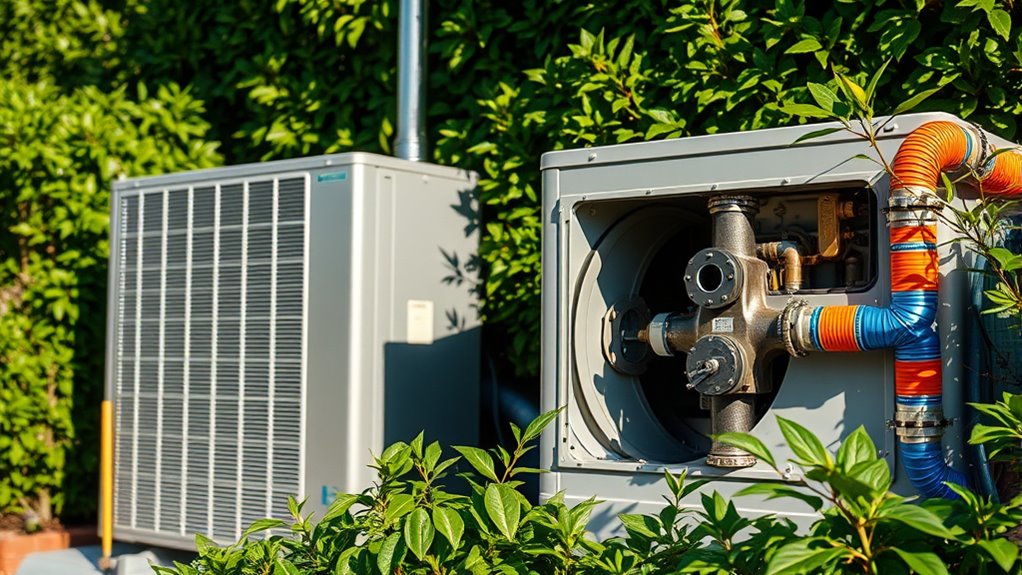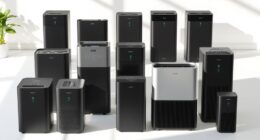Switching to variable-speed pumps and heat pumps can substantially lower your energy bills by optimizing system efficiency. These systems adjust their output based on demand, running at lower speeds when less heat or flow is needed, which conserves energy. They also provide better temperature control, reduce wear, and last longer. If you want to understand how these advanced systems can save you money and improve comfort, keep exploring the benefits they offer.
Key Takeaways
- Variable-speed pumps and heat pumps optimize energy use by adjusting output based on demand, reducing unnecessary power consumption.
- These systems operate smoothly at lower speeds, providing better temperature control and decreasing energy bills over time.
- Regular maintenance, like filter changes and coil cleaning, ensures peak efficiency and maximizes savings on energy costs.
- Upgrading to these systems can be cost-effective long-term, especially in moderate climates suited for heat pump efficiency.
- Proper system sizing and professional installation are essential to achieve maximum energy savings and system reliability.
Understanding How Variable-Speed Pumps Operate

Variable-speed pumps adjust their motor speed based on the system’s demand, providing efficient and precise flow control. Instead of running at full power constantly, they modulate their speed to match what’s needed at any moment. When your system detects a lower demand, the pump slows down, saving energy and reducing wear. Conversely, if demand increases, the pump speeds up to ensure consistent flow. This dynamic adjustment happens automatically through built-in sensors and advanced control systems. As a result, you get smoother operation, less noise, and improved efficiency. Unlike traditional pumps that operate at a fixed speed, variable-speed models respond intelligently to real-time needs, optimizing performance and energy use. This smart operation is what makes them a popular choice for energy-conscious systems.
The Benefits of Variable-Speed Pump Technology
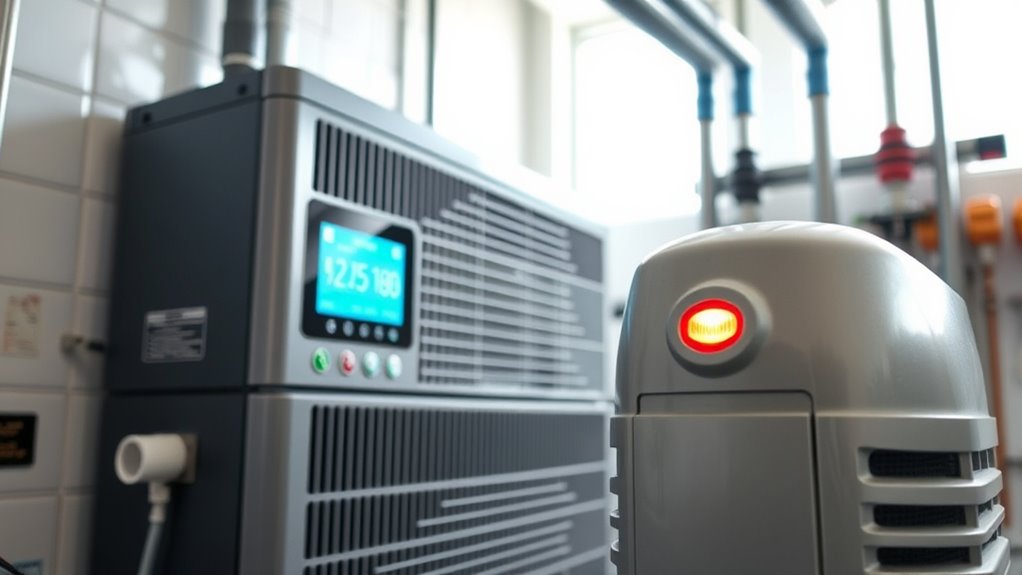
One of the biggest advantages of variable-speed pump technology is its ability to markedly boost energy efficiency. Unlike traditional pumps that run at full power only or turn off when not needed, variable-speed pumps adjust their motor speed based on demand. This means they operate at lower speeds when less flow is required, consuming less energy. As a result, you experience lower utility bills and reduced environmental impact. These pumps also provide smoother operation, minimizing wear and tear, which extends their lifespan. Additionally, they offer better control over your system’s temperature and flow rates, enhancing overall comfort and system performance. By investing in variable-speed pump technology, you optimize energy use, save money, and enjoy a more reliable, eco-friendly system. Understanding energy efficiency principles can help you make more informed decisions about your HVAC investments.
Exploring Heat Pump Functionality and Types
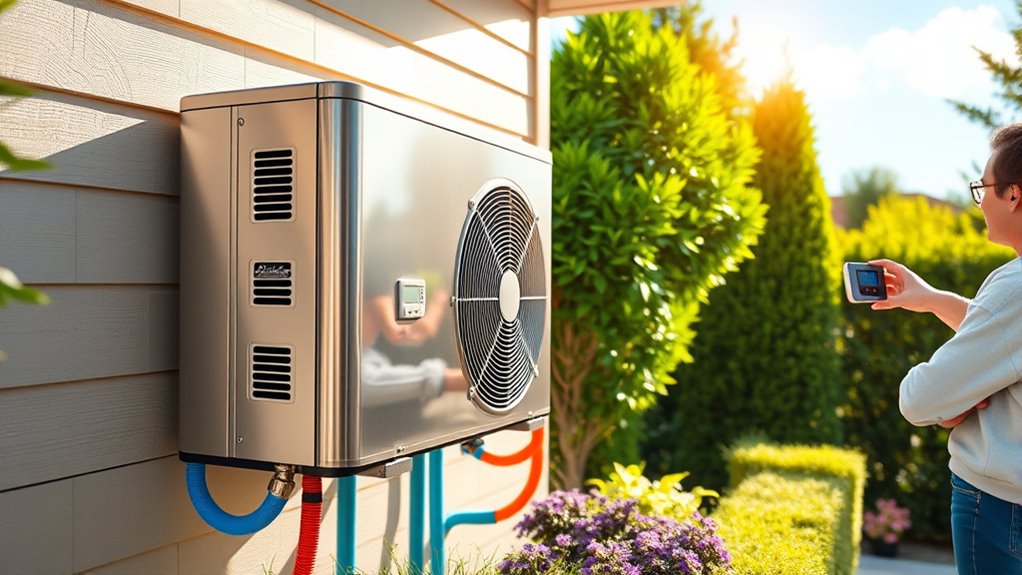
Heat pumps are versatile systems that can both heat and cool your home by transferring heat between the indoor and outdoor environments. In heating mode, they extract heat from outside air, even in cold weather, and move it indoors. During cooling, they reverse the process, removing heat from inside and releasing it outside. There are mainly two types: air-source and ground-source (geothermal) heat pumps. Air-source units are common and easier to install, using outdoor air as a heat source or sink. Ground-source heat pumps tap into the stable underground temperature, offering higher efficiency but with higher upfront costs. Some models include hybrid systems that switch between heat pumps and traditional furnaces for optimal performance. Understanding these types helps you choose the right system for your climate and needs. Efficiency can vary significantly depending on the type and installation quality of the heat pump.
Comparing Traditional Systems With Variable-Speed and Heat Pumps

Traditional heating and cooling systems typically operate at a fixed speed, cycling on and off to maintain temperature, which can lead to energy inefficiency and temperature fluctuations. These systems often run at full capacity, even when only a little heating or cooling is needed, wasting energy. In contrast, variable-speed pumps and heat pumps adjust their output based on your home’s actual needs. They ramp up or down smoothly, maintaining consistent temperatures and using less energy overall. This flexibility reduces wear and tear, extending the system’s lifespan. Additionally, security vulnerabilities in new technologies can pose risks if not properly managed. While traditional systems might seem simpler, they often cost more in energy bills over time. By comparing these systems, you can see how modern technology offers smarter, more efficient ways to heat and cool your home effectively.
Cost Savings and Energy Efficiency Advantages
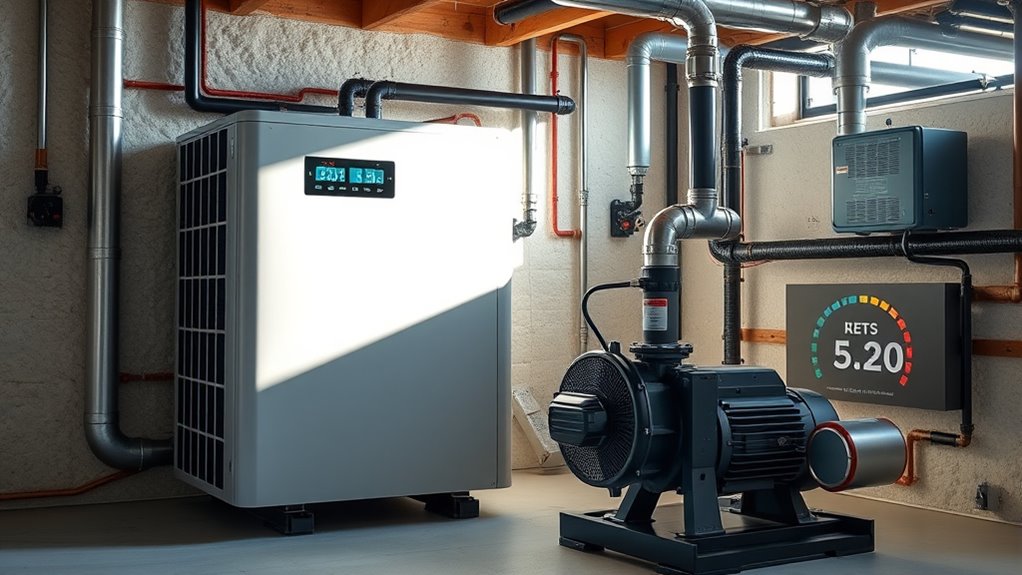
Are you aware of how much energy your heating and cooling systems can save you over time? Variable-speed pumps and heat pumps adjust their output based on your home’s needs, reducing unnecessary energy use. Unlike traditional systems that run at full power then shut off, these advanced units operate at lower speeds, maintaining consistent temperatures efficiently. This precise control cuts down on wasted energy, lowering your utility bills. Additionally, their improved efficiency means less strain on the system, extending its lifespan and reducing maintenance costs. Over the long term, these savings can add up considerably. Investing in variable-speed and heat pump technology not only benefits your wallet but also helps reduce your carbon footprint, making your home more environmentally friendly. Modern heat pumps with quieter operation further enhance comfort by minimizing noise disturbances around your home.
Installation Considerations and Compatibility

Before installing a variable-speed pump or heat pump, you need to make certain your system meets compatibility requirements. Proper setup can prevent performance issues and maximize efficiency. Working with a professional can help you navigate installation tips and ensure everything fits seamlessly. Additionally, understanding your system’s compatibility with energy-efficient components can lead to better long-term savings. System compatibility is a crucial factor in achieving optimal performance and energy savings.
System Compatibility Requirements
Ensuring your variable-speed pump or heat pump is compatible with your existing system is essential for peak performance and efficiency. Compatibility depends on factors like size, control wiring, and system type. Before upgrading, verify that your system can handle variable-speed technology to avoid issues. Check your current system’s specifications and consult manufacturer guidelines.
| Compatibility Factor | Requirements | Notes |
|---|---|---|
| System Type | Compatible with heat pump or boiler | Not all systems support variable-speed |
| Control Wiring | Proper wiring for communication | May need upgrades or adapters |
| Sizing | Correct capacity for your system | Avoid undersizing or oversizing |
Professional Installation Tips
Proper installation plays a key role in maximizing the benefits of your variable-speed or heat pump system. To guarantee it performs ideally, pay attention to these key considerations:
- Choose the Right Location: Install your unit where it’s protected from extreme weather and has adequate airflow for efficiency.
- Verify Compatibility: Confirm that your existing ductwork and electrical systems are compatible with the new system to avoid costly modifications.
- Hire Certified Professionals: Work with HVAC technicians experienced in variable-speed and heat pump installations to ensure correct setup and calibration.
- Ensure Proper Sizing: Properly sized units are essential for optimal performance and efficiency, preventing issues like short cycling or insufficient heating and cooling. Proper sizing is often overlooked but critical for system longevity.
Following these tips helps prevent issues, enhances efficiency, and extends your system’s lifespan, ultimately saving you more energy and money.
Maintenance and Longevity of Modern Pumps
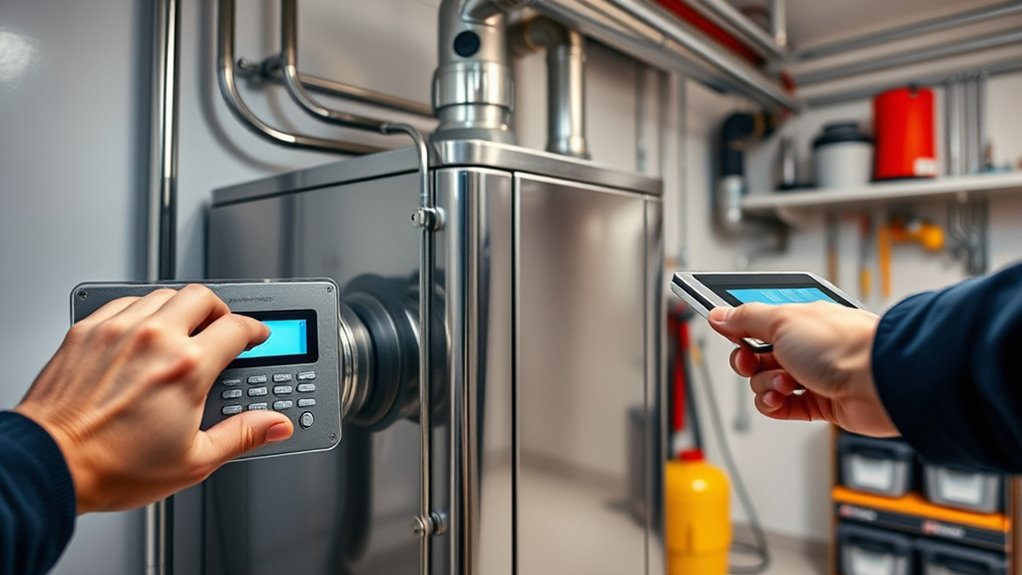
Regular maintenance is essential to keep modern variable-speed and heat pumps operating efficiently and extending their lifespan. You should regularly check and replace filters, keep vents clear, and schedule professional inspections annually. This helps prevent dust buildup, reduces strain, and guarantees optimal performance. Proper lubrication of moving parts also minimizes wear and tear. To help you stay organized, here’s a quick maintenance checklist:
| Task | Frequency | Benefit |
|---|---|---|
| Replace filters | Every 1-3 months | Maintains air quality, efficiency |
| Clean condenser coils | Annually | Enhances heat transfer, saves energy |
| Inspect ductwork | Annually | Prevents leaks, improves airflow |
| Lubricate moving parts | As needed | Reduces mechanical wear |
| Schedule professional tune-up | Annually | Extends system life, improves efficiency |
Regularly checking system efficiency can help identify issues early and ensure your pumps operate at peak performance.
Making the Switch: Is It Right for Your Home?

Thinking about upgrading to a variable-speed or heat pump can seem overwhelming, but understanding if it’s the right choice for your home is the first step. Consider these factors:
- Climate Compatibility: If you live in moderate temperatures, heat pumps work efficiently year-round. Colder climates may require additional features or hybrid systems.
- Energy Savings Goals: If reducing energy bills is a priority, these systems adapt to your usage, lowering costs over time.
- Installation & Budget: Ensure your home’s existing infrastructure supports the upgrade and weigh upfront costs against long-term savings.
- Proper Sizing and Efficiency Ratings: Evaluating the system’s SEER and HSPF ratings can help you select a model that maximizes efficiency and comfort for your home.
Assess your climate, goals, and budget to decide if switching aligns with your needs. Consulting a professional can help determine if this upgrade makes sense for your home.
Frequently Asked Questions
How Do Variable-Speed Pumps Impact Indoor Air Quality?
Variable-speed pumps improve your indoor air quality by maintaining consistent airflow and humidity levels, which helps prevent mold and dust buildup. They adjust their speed based on your home’s needs, ensuring better filtration and reducing airborne allergens. This continuous, stable operation creates a healthier environment, making your indoor space more comfortable and safe. You’ll notice cleaner air and fewer respiratory issues as a result of these efficient, adaptive systems.
Are Heat Pumps Suitable for Extreme Cold Climates?
Think of a heat pump as a brave explorer traversing icy mountains. In extreme cold climates, modern heat pumps are equipped with advanced technology, allowing them to perform efficiently even when temperatures drop. While traditional models struggle, newer units can provide reliable heating, making them suitable for harsh winters. So, with the right choice, you can stay warm and cozy, regardless of how cold it gets outside.
What Are the Potential Noise Differences Between Traditional and Modern Pumps?
Modern pumps are typically quieter than traditional ones due to improved motor design and sound insulation. You’ll notice less vibration and noise during operation, especially with variable-speed models that run more smoothly and gradually adjust their power. Traditional pumps may produce more hum and abrupt sounds. If noise levels are a concern, opting for newer, modern pumps can provide a quieter, more comfortable experience in your home.
Can Existing HVAC Systems Be Upgraded With Variable-Speed Technology?
Think of upgrading your HVAC system like giving your home a heart transplant — it’s possible and can be life-changing. Yes, you can upgrade your existing system with variable-speed technology, but it depends on your current setup. You might need compatible components or a full replacement. Consulting a professional ensures you get the right upgrade, making your system more efficient and quieter, just like giving your home a new, energized heartbeat.
How Do Maintenance Costs Compare for Heat Pumps Versus Traditional Systems?
Maintenance costs for heat pumps are generally comparable to traditional systems, but they can be slightly higher due to their more complex components. You might spend more on occasional repairs or professional servicing. However, they tend to last longer and operate more efficiently, which can offset some maintenance expenses over time. Regular upkeep, like filter changes and inspections, helps keep costs manageable and ensures your system runs smoothly.
Conclusion
Switching to variable-speed and heat pump systems is like opening a secret door to lower energy bills and greater comfort. By embracing these technologies, you’re not just saving money—you’re stepping into a smarter, more efficient home. Don’t let outdated systems hold you back; instead, harness the power of innovation to transform your energy use. After all, isn’t it time you took control and made your home work smarter, not harder?

